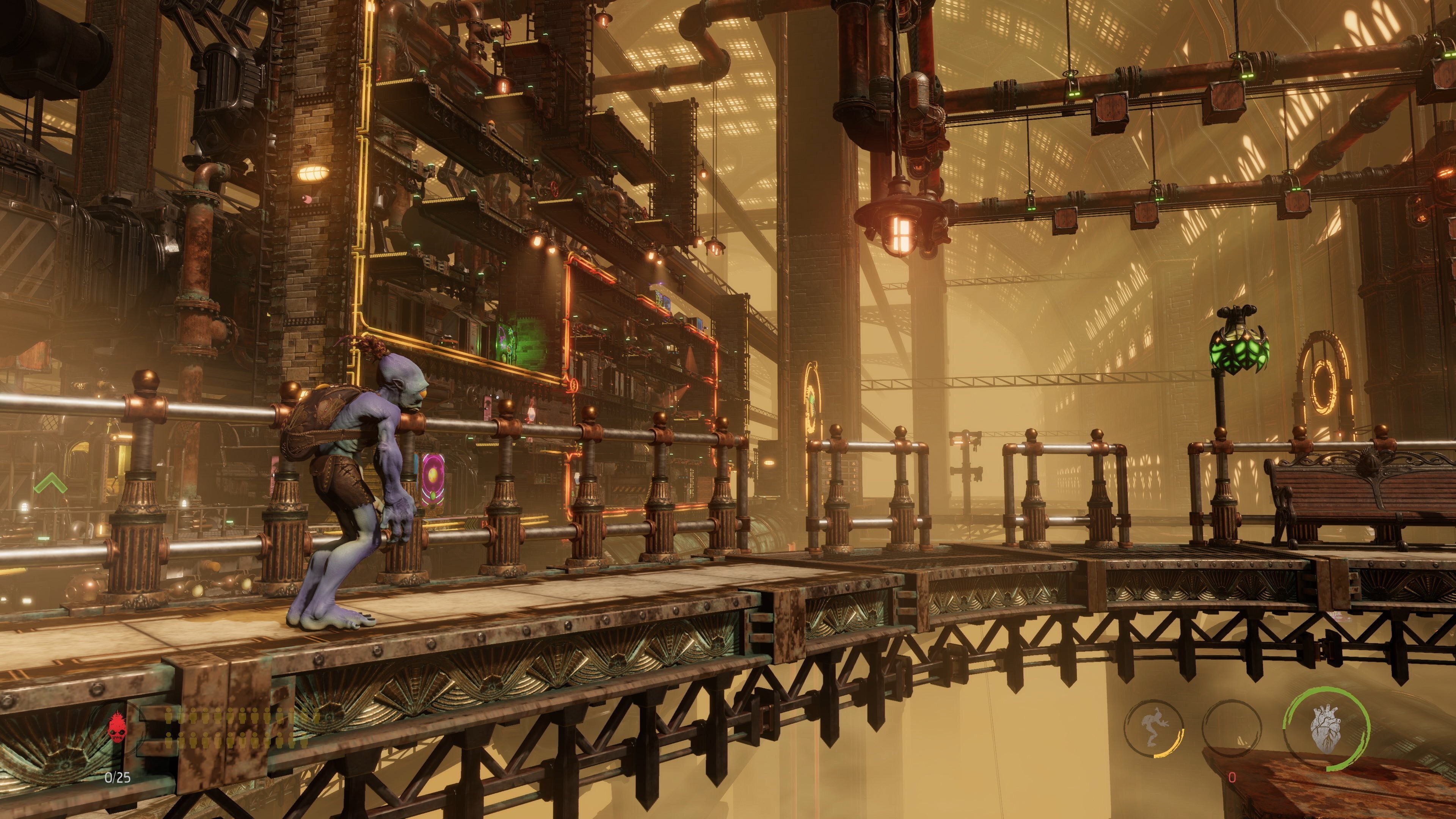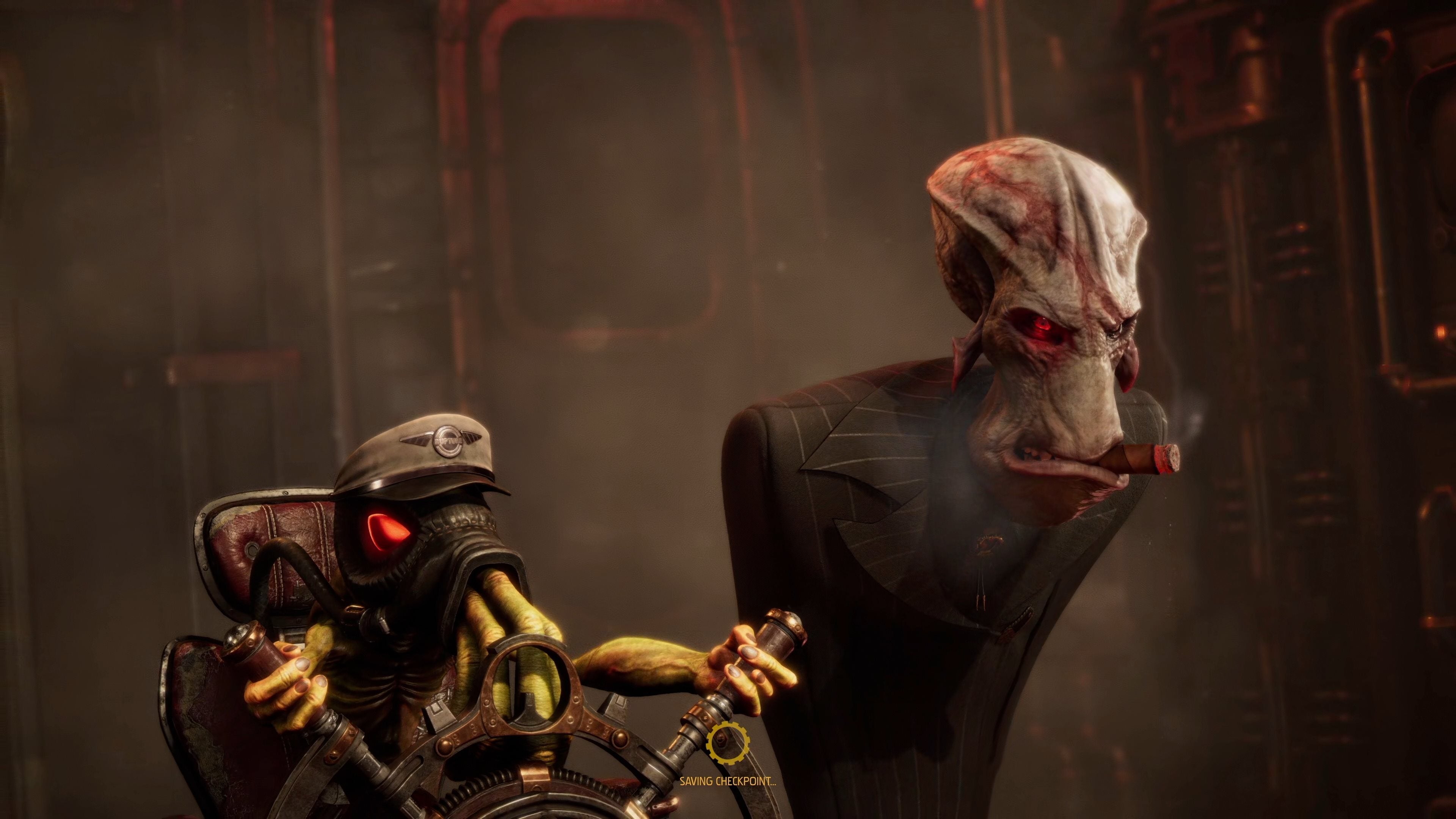It’s also a showcase for the Unity Engine. This powerful tool has enabled many creators to deliver remarkable games but with the latest rendering techniques made possible by the engine and a focus on physics and AI, it offers something quite unlike any other Unity-based game we’ve played. But let’s be clear: Soulstorm is not a game for everyone. As ambitious and far-reaching as it is in so many respects, there’s still something old-school about it - not least its difficulty level, which can be brutal, just like the older games in the series. But for my money, it’s fresh and different and while the muted aesthetic has caused issues for some, dig deeper into the game and you’ll find a truly beautiful experience, albeit one that’s best played at 60fps on PS5 and PC. At its core, Soulstorm is still the same kind of side-scrolling platformer as the first two franchise entries on PS1 and of course, New ’n’ Tasty on the last-gen machines. You run, jump, climb ledges and lead Mudokons to freedom - but there’s much more to the game now. What the team has delivered is something I love in video games: a true systems-driven playground. Each stage offers an increasingly complex series of challenges to conquer while your available toolset slowly fills out. Without spoiling too much, it begins simply enough - you’re initially taught that water bottles put out fire, then this progresses to the player receiving a new bottle that does the opposite, propagating fire. In turn, this demonstrates that wood objects can burn. Light a wooden structure on fire and the inferno spreads, before scenery eventually collapses in a display of physics. After this, you’ll start to encounter AI opponents and it’s at this point that the tools and techniques begin to ramp up. Much of the game focuses on toying with the enemy AI, much like a good stealth game. Also like a good stealth game, enemy behaviour is clearly telegraphed and defined. Between UI elements, sight cones and general behaviour, you’ll have a solid grasp on how enemies will react and interact with the systems you’ve learned. This is where Soulstorm really starts to differ from its predecessors. In the original games, you were mostly on the defense - hiding from enemies, sneaking by. Now Abe has more offensive moves from using inventory objects against his foes, to knocking out enemies by hand and tying them up. You’ll obscure yourself from enemy gaze by lurking within steam, you’ll hide in lockers Metal Gear-style and possess your enemies to turn them on their allies. All of this is built from the original Oddworld concepts but massively extended. When you couple this with the vastness of the stages and the robust physics simulation, the gameplay starts to becoming truly emergent. The more you experiment, the more you’ll see how all of the game’s systems logically interact with one another - it’s a game that compels you to think laterally and to test out your theories. Where Soulstorm really comes together is in how these systems integrate with some beautiful set-pieces, delivering a stand-out experience (the sky train in particular is an absolute treat). The game is just constantly introducing new, fun ideas with clear rules and plenty of challenge. While not exactly holding your hand, Soulstorm takes pains to highlight the rules of engagement. You also start to pick up more items and trinkets along the way which can eventually be used to craft new objects. I’m not usually a fan of crafting but I found it very immediate and fun in this case. From creating smoke bombs that you can use to create dynamic cover for stealth, to bouncing balls you make from rock candy, and rubber bands which take out enemies - your toolkit continues to expand. And that’s really what I mean by systems-driven: all of these tools, objects and scenarios are always clearly defined by the game but the player has a lot of agency in terms of how to tackle them, especially later on in the game. But what really sells all of this are the visuals. Soulstorm delivers a gorgeous 3D world to explore: it has a feeling that reminds me of a classic Team ICO game in some ways with towering architecture and vast open spaces. Much of the world is visible and active well into the distance, to the point where far-off structures are actual destination points and where telescopes can be used to preview the trials ahead. Each map stage consists of a large primary environment with multiple interiors. Exploration is completely seamless and the stages are lengthy. The game also manages to throw around a large number of characters on-screen - sometimes you’ll see what feels like hundreds of Mudokons scurrying across the backgrounds and, in some scenes, you’re tasked with protecting them as they make their escape. You’ll spot limitations in these instanced models if you look closely but it’s still very effective at conveying huge crowds. It’s an interesting presentation then - the tone of the game means that some areas can appear rather drab and the first couple stages may not impress, but as you play, the more these details begin to stick out. It’s as large and detailed a world as we’ve seen in a side-scrolling game like this. However, while I love the visual design, there are some limitations. Firstly, texture quality, while generally solid, can sometimes appear lower res than expected - some materials are noticeably blurrier. Then there are the cutscenes, where Oddworld relies on pre-recorded videos rather than in-game cinematics. At least they’re 60fps on PS5, but unfortunately, they’re locked to 30fps on PC, in line with the last-gen console versions. The overall presentation is superb but how good it looks depends on your platform of choice. PlayStation 5 renders at a native 1440p, but the anti-aliasing solution is lacking and temporal stability is poor, leading to lots of sparkle and some jaggies. PC can run at a higher pixel-count but these artefacts are still present, even at native 4K. Both PS4 Pro and PS4 run at 1080p but shadow and lighting quality is cut back on the base machine, while frame-rate tops out at 30fps up against the mostly solid 60fps on PS5. PS4 Professional runs smoothly enough at its target 30fps for the most part but does have some noticeable dips. Meanwhile, the vanilla PS4 ‘Amateur’ has some profound performance issues in the game’s more challenging areas. A double-buffer v-sync solution sees frame-rates drop as low as 20fps, perhaps not surprising when looking at the highly taxing physics on display here. On top of this, all versions (even PC!) suffer from noticeable checkpoint stutter, which is jarring. The PC version won’t win you over with a comprehensive settings collection but it does allow for more customisation with selectable resolutions, but this has its limitations - ultra-wide monitor support is not available, but at least it does offer higher frame-rate options that are very useful indeed. I just feel that we need a toggle to download and replace the 30fps video sequences. With that said, there is the sense that while Soulstorm is a cross-gen title, the developers designed this game primarily with PlayStation 5 and PC in mind. The extra horsepower is required to really let this title shine - and I absolutely loved my time with the game. The emergent gameplay, the smart level design and the beautiful art direction really speak to me - but there’s a decidedly old-school mentality to it that may not work for everyone. It also launched with a fair few bugs which may have put some people off, but most of my major issues with the code were addressed in a patch. But honestly, I love this game: it’s a perfect fusion of retro and modern concepts that fit together into a surprisingly cohesive whole. It has rough edges for sure but it’s a quality game. It also represents the first new Oddworld experience since 2005 - New ’n’ Tasty was excellent but it was very much a remake. Soulstorm is inspired by Abe’s Exoddus but it’s effectively a brand-new game bringing a lot of fresh ideas. Yes, it’s frustrating at times, but ultimately - it’s worth it.

